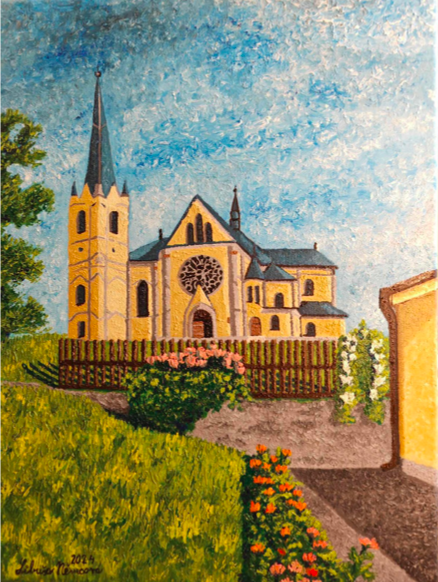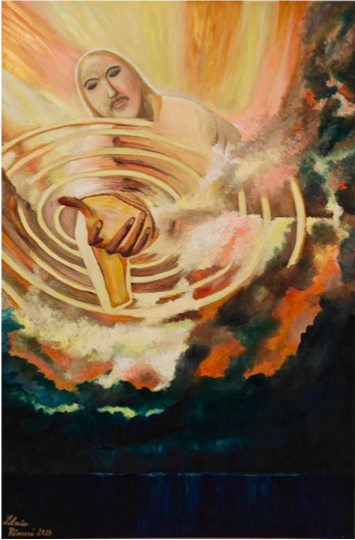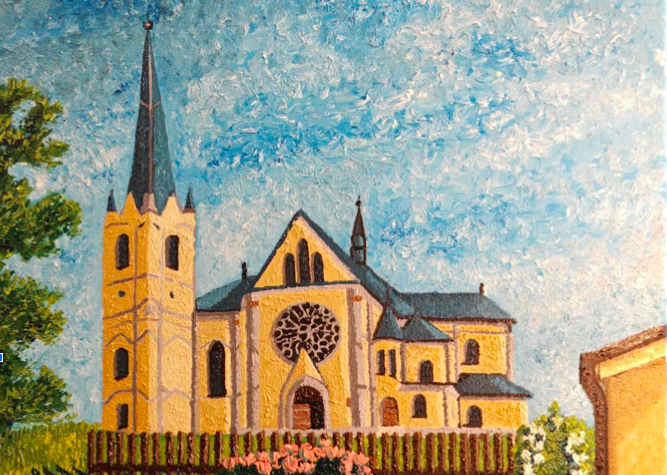Libuša Němcová, a Swiss artist originally from Košice, Slovakia, has taken a path that blends resilience, dedication, and creativity. Like many, she set aside her childhood passion for drawing as the realities of adult life took over. Working as a 24-hour home help abroad, she managed the practicalities of daily existence while quietly holding onto a love for art.
It wasn’t until her second marriage, a period of transformation and self-discovery, that she found the courage to return to creativity. With her children becoming independent, she finally had the space to focus on her artistic pursuits. Moving to Switzerland in 2016 proved to be a turning point. The vast Alpine landscapes, the changing light, and the sense of tranquility became the backdrop to her artistic rebirth. Her work now reflects both the physical beauty of the world around her and the deeper, emotional layers of personal and spiritual experience.
Mária Hill: A Landscape of History and Devotion

One of Libuša’s paintings, Mária Hill, captures a scene rich with history and spirituality. Measuring 40 x 30 cm and framed in an elegant wooden frame of 50 x 70 cm, the painting portrays Mariánska Hora in Levoča, Slovakia.
The composition is simple yet evocative. The church, perched on the hill, stands out against a backdrop of rolling greenery and an expansive blue sky. There is a peaceful stillness in the scene, enhanced by the contrast between the bright white of the church walls and the deep, earthy tones of the landscape. Fine details bring out the architectural beauty of the church, while soft brushstrokes in the sky create a sense of openness and airiness.
The painting is more than just a representation of a place; it is a connection to history and faith. Levoča is a site of pilgrimage, and Mariánska Hora holds deep cultural and religious significance. By painting this scene, Libuša preserves not just an image, but the emotion and devotion tied to it. The careful attention to light and shadow gives the piece depth, making it feel both real and dreamlike.
Displayed in its sturdy frame, Mária Hill carries a quiet elegance. It offers viewers a moment of reflection—a chance to connect with a place that has stood the test of time, just as faith and history endure.
A Helping Hand: Symbolism in Art

Another piece, A Helping Hand, moves from landscapes to a more symbolic and religious theme. This oil painting, measuring 120 x 80 cm, captures a moment of transformation and grace. At the center, a striking wather—an element often associated with change and renewal—becomes the focal point. Above it, a holy figure extends a hand, offering guidance and support. It is a quiet but powerful representation of divine presence in everyday life.
The colors in A Helping Hand are vibrant, drawing the eye to the interaction between the figure and the wather. Intricate brushwork adds texture and depth, making the scene feel dynamic. Unlike Mária Hill, which is rooted in a specific location, this painting is more open to interpretation. It speaks to anyone who has ever felt lost and in need of guidance, making it deeply personal yet universal.
Housed in a strong wooden frame, the painting carries both artistic and spiritual weight. It serves as more than just decoration—it is a daily reminder of faith, hope, and the unseen forces that shape our lives.
Though A Helping Hand has already been sold, its impact remains. Like much of Libuša’s work, it is a bridge between the tangible and the intangible, between the seen and the felt.
Art as Reflection
Libuša Němcová’s journey is one of patience and persistence. She does not rush her process; instead, she allows her experiences to shape her art naturally. Whether she is painting landscapes that carry deep historical significance or symbolic works that explore faith and transformation, her work remains deeply personal.
Her paintings invite the viewer to slow down, to observe, and to feel. They are not just about places or figures but about the emotions tied to them. Whether inspired by the landscapes of Slovakia or the spiritual themes that run through her work, Libuša’s art is, at its core, an exploration of connection—between past and present, between the physical world and the unseen, and between the artist and those who view her work.

